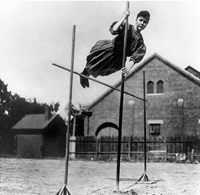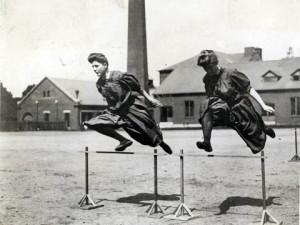Ina Road. You’ve probably used this local thoroughfare many times, but perhaps you don’t know how its name came about. The following excerpt from Claiming the Desert – Settlers, Homesteaders and Ranchers in Oro Valley, Arizona 1865-1965 by James A. Williams provides the explanation.
Ina Gittings was an early women’s educator, a community volunteer and a homesteader. She was born in 1885 in Wilbur Nebraska. Ina was a professional woman ahead of her time. She earned a university degree from the University of Nebraska in 1906. She led a successful, independent life and never married.

She was a trailblazer in women’s athletics. Gittings came to teach and serve as a Director of Women’s Physical Education at the University of Arizona in 1920. She completed a Master’s Degree there in 1925 and continued to teach at the university until 1955. Men’s sports received the vast majority of athletic funds. “We struggled to get everything they (the girls) wanted, to keep them interested. It was quite a battle sometimes, but we succeeded,” she later remembered. She introduced female students to archery, track and field, horseback riding and other sports. At one point , the women needed an extra athletic field for newly introduced sports. Only the Department of Agriculture’s onion fields were available. Ina won the battle and obtained the onion fields, but she and the female athletes had to harvest the onions themselves.

She was also one of this area’s pioneers. She claimed two parcels of federal land totaling 480 acres under the Homestead Acts in 1928 and 1931. One parcel of 160 acres was located in what is now Rancho Vistoso, along Rancho Vistoso Boulevard and includes what is now most of the Vistoso Vista subdivision. The other parcel, along what is now Ina Road, totaled 320 acres. This was located east of La Cholla Boulevard, between Magee Road and Ina Road. Her residence was at the second parcel. Homesteaders were not required to live full time on their claim. Gittings had a home near the university and probably visited the homestead on weekends, as many Tucsonans did.
Professor Gittings stepped down from her university position in 1951. She kept her professorship and some teaching duties until fully retiring in 1955. Richard Harvill, president of the University in the 1960s said: “Miss Gittings served the University with complete dedication and competence for 35 years” and her influence on young women “was well known and widely recognized.” She often delivered talks on physical education and health to local organizations into the 1960s.
Ina Road was named for her. It was an unpaved highway when she homesteaded in the early 1930s. Gittings pronounced her name “EE-nah” but our local Ina Road has come to be pronounced “EYE-nah”. She wrote several letters to local newspapers complaining about people mispronouncing “her” road.
Ina Gittings died in 1966. The Gittings Memorial Fund at the University was established in her honor. She is listed on the Women’s Plaza of Honor on the University of Arizona campus, and Gittings Hall was built there in 1964 and named for her. When you drive on Ina Road, remember a women’s education pioneer and Oro Valley homesteader, Ina (EE-nah) Gittings.
Jim Williams, author of Claiming the Desert, is a local resident, retired teacher and historian. He is an Honorary Member of the Oro Valley Historical Society (OVHS) and former president of the same. If you would like to learn more about Oro Valley homesteaders you can purchase his book at amazon.com or through the Oro Valley Historical Society (contact tcolmar@comcast.net). Jim generously donates profits from his book to OVHS!